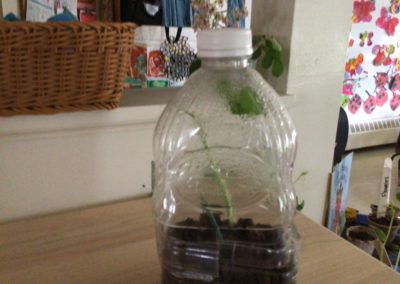Greenhouse Growing
Developed by Jacquelyn Bell, PCM Play Intensive 2021
(FOCUS: Pre-K, Science, Technology, Arts, Engineering and Mathematics, Design thinking, Engineering Design Process, Creativity and Making, Recycling)
How do fruits and vegetables grow in the cold weather? Many farmers use large greenhouses to plant seeds and begin the growing process when it is still too cold outside. We can use a mini greenhouse to begin our own vegetable seeds and watch as the seeds sprout seedlings and grow into plants that will produce vegetables. All we need are seeds, soil and an enclosure that keeps the warm air in and the cold air out.
We will build a mini greenhouse to grow vegetable plants from seeds. To make our greenhouse we will recycle clear, plastic bottles to use as a greenhouse. The clear bottles will allow us the chance to see the roots and growth that happens under the soil as well as above the soil
It is important in cold climates to be able to grow fruits and vegetables. During the winter fruits and Vegetables often have to be shipped in from warmer states. Especially In our region where the weather can be unpredictable, snowing one minute warm the next, having a climate-controlled area to grow plants becomes very important.
Materials
- Clear large plastic bottle with a screw on top: such as juice, water or soda. Larger juice bottles are perfect for this but any clear bottle will do
- Masking tape and sharpie
- Notebook for recording observations
- Exacto knife or scissors
- Seeds (Bean seeds are the best for watching the entire process unfold. There are many different kinds of beans/peas to choose from in the seed section of the garden center of any store)
- Cups, spoons
Set Up:
Teachers should use a knife or sharp scissors to cut bottles in half prior to experiment.
Create a station with precut bottles, soil, spoons, and a cup of water for each student. Teachers should pass out seeds after students fill their bottles with soil.
Student’s Job
How can we grow food when it is cold outside?
- Get soil, seeds and clear bottle cut in half.
- Put the soil in the bottom of the bottle. Use your hands, cups, spoons or anything you want to fill it up.
- Plant 3-5 seeds, depending on the size of your bottle and the seeds direction.
- Water lightly. Make sure soil Is moist to the touch but not “muddy”. Place the top over the bottom of the bottle, cut slits up sides if it won’t close.
- Place a piece of masking tape on the outside of the bottle. Record date planted and name and number of seeds planted.
- Put in warm area.
- Draw a picture of what you see the first day. Every day following draw what you see In the bottle. Look at the soil, the roots, the air In the bottle and look for signs of sprouting.
- Once seedlings appear, measure daily to chart the growth of the seedling Inside the greenhouse. Once the seedling Is as tall as the bottle, take the top off. Replant In bigger container. If warm enough outside, plant In garden.
Teacher’s Job
Standards Alignment
RI EARLY LEARNING AND DEVELOPMENT STANDARDS: SCIENCE
Component 1: Scientific Inquiry and Application
Children learn to plan for and carry out investigations and collect, evaluate, and communicate information.
Component 2: Knowledge of Science Concepts
Children explore the characteristics of objects and materials that are living, non-living, man-made, or naturally occurring.
Effective Facilitation
Use crayons and notebook to draw what you see.
Make predictions on how long the seedling will take to appear. What happens to the air Inside the greenhouse compared with room temperature?
Draw a picture of what you think the seedling and plant will look like once growing.
Draw a picture of what It really looks like and compare the two pictures. What do you notice?
Prepare/ Background Info
Printout of plant lifecycle, what seeds/plants need to grow.
Extend/ Take It Further
Once the seedlings emerge, take off top, and look at bottom for roots to appear. Children can also plant seeds and have them grow without the top on. They can chart growth and compare the seedlings to each other, one in the greenhouse, one in plain air.


0 Comments